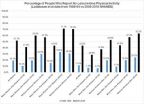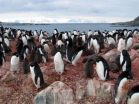(Press-News.org) Let's say you're a bee and you've spotted a new and particularly lucrative source of nectar and pollen. What's the best way to communicate the location of this prize cache of food to the rest of your nestmates without revealing it to competitors, or "eavesdropping" spies, outside of the colony?
Many animals are thought to deter eavesdroppers by making their signals revealing the location or quality of resources less conspicuous to outsiders. In essence, they've evolved "whispers" in their signals to counter eavesdropping.
But some species of bees in Brazil do the exact opposite. "Shouts" in their food-recruitment signals warn would-be competitors that their prime source of food will be fiercely defended if they show up to the site. It's a communication strategy that's bold and risky, yet remarkably successful in warding off competitors, according to a paper published in the July 7 issue of the journal Current Biology.
"It's a signal with honest aspects and the possibility of lies," explains James Nieh, a professor of biology at UC San Diego who oversaw the research study conducted in Brazil by Elinor Lichtenberg, a PhD student in his laboratory who is now a postdoctoral researcher at Washington State University. "It tells nestmates where to find good food and hints at a larger occupying force."
Lichtenberg says her discovery of this counterintuitive method of communication by bees suggests that eavesdroppers can alter the evolution of animal signals in ways that were previously not thought possible.
"Our study provides a new way of looking at how eavesdroppers affect the evolution of animal communication signals," she adds. "Until now, it was thought that eavesdroppers select against conspicuous signals, for example by more easily finding and eating prey that sings loudly. But our results show that eavesdroppers can help select for the same conspicuous signals that are easiest for intended recipients to detect and understand."
To Nieh, whose research has focused on the evolution of communication strategies among bees, "eavesdropping is part of the information web, the signals and cues that surround animals and play a key role in shaping ecosystems."
In the case of bees and other pollinators, he says, "a network of signals and cues shapes pollination, informing animals about where and when food is available. Researchers have in general thought about eavesdropping as a force that makes signals less conspicuous, leading to the evolution of 'whispers' to counter spying. However, we show that eavesdropping can also lead to 'shouts.' In this stingless bee system, with aggressive colonies jockeying for limited resources, more conspicuous food-recruitment signals indicate a higher likelihood that a resource will be harder to wrest away."
Lichtenberg's study focused on stingless bees—including two from the genus Trigona that recruit nestmates to food sources with chemically distinct pheromones—that compete with one another for similar food sources. Trigona hyalinata spies that detect food sources marked by Trigona spinipes foragers will often displace T. spinipes from desirable sites in the wild if they can recruit sufficient nestmates. But Lichtenberg found in a controlled field study that the eavesdropping species will avoid desirable sources of food that have been visited frequently by T. spinipes (communicated by the larger number of pheromone markings at the site) to avoid being attacked. However, T. hyalinata foragers are attracted to food sources with fewer T. spinipes foragers.
The eavesdroppers could take over the highly visited sites by recruiting more of their nestmates or battling with T. spinipes bees, which show high levels of aggression toward intruders, but the risks and energy costs to the eavesdroppers apparently aren't worth the trouble.
The researchers supported this hypothesis by modeling eavesdropping bees' decision-making, using a type of model from economics. They ran the model for T. hyalinata eavesdropping on T. spinipes, T. spinipes on T. hyalinata, and the non-aggressive Melipona rufiventris on T. spinipes. In all three cases, they found that the model results matched eavesdropping behavior measured in this study and in previous work by Lichtenberg, Nieh and colleagues.
"Assembling such a group in the nest after having found a food source through eavesdropping uses time and energy the eavesdropper could otherwise spend looking for an unoccupied food source," explains Lichtenberg. "If the eavesdropper brings too small a group to an occupied food source and cannot win access to it, she and the bees accompanying her have essentially wasted energy. For attacks between colonies of the same species, there is also a risk that the conflict will escalate to physical interactions in which large numbers of bees may die."
"Our study is one of the first to investigate what drives the behavior of eavesdroppers collecting information from competitors within the same trophic level, which use the same food resources as the eavesdropper," she adds. "Previous eavesdropping research has mainly focused on individuals seeking mates, predators looking for prey or prey trying to avoid being eaten. In those cases, eavesdroppers' expected behavior is clear. This is not true for eavesdropping on competitors."
The study not only provides information about the evolution of different strategies of animal communication, but suggests how these strategies can affect the ecology of plant communities. "Such strategies affect not only the individuals directly involved, but also broader ecological interactions between the food-gatherers and their food," Lichtenberg says. "This is particularly important for animals such as the bees I studied, because their movements determine plant pollination."
INFORMATION:
Other authors of the paper were Joshua Graff Zivin of UC San Diego's School of International Relations and Pacific Studies and Michael Hrncir of Brazil's Universidade Federal Rural do Semi-Árido, where the study was conducted. Funding for the study was provided by grants from the National Science Foundation and the Animal Behavior Society.
Why 'whispers' among bees sometimes evolve into 'shouts'
2014-07-07
ELSE PRESS RELEASES FROM THIS DATE:
Obesity, large waist size risk factors for COPD
2014-07-07
Obesity, especially excessive belly fat, is a risk factor for chronic obstructive pulmonary disease (COPD), according to an article in CMAJ (Canadian Medical Association Journal)
Excessive belly fat and low physical activity are linked to progression of the disease in people with COPD, but it is not known whether these modifiable factors are linked to new cases.
A team of researchers in Germany and the United States looked at the relationship of waist and hip circumference, body mass index (BMI) and physical activity levels to new cases of COPD in a large group of men ...
Less exercise, not more calories, responsible for expanding waistlines
2014-07-07
Philadelphia, PA, July 7, 2014 – Sedentary lifestyle and not caloric intake may be to blame for increased obesity in the US, according to a new analysis of data from the National Health and Nutrition Examination Survey (NHANES). A study published in the American Journal of Medicine reveals that in the past 20 years there has been a sharp decrease in physical exercise and an increase in average body mass index (BMI), while caloric intake has remained steady. Investigators theorized that a nationwide drop in leisure-time physical activity, especially among young women, may ...
Mind the gap: Socioeconomic status may influence understanding of science
2014-07-07
MADISON — When it comes to science, socioeconomic status may widen confidence gaps among the least and most educated groups in society, according to a new study by researchers at the University of Wisconsin-Madison's Science, Media and the Public research group.
The findings, published in June in the journal Science Communication, show that similar levels of attention to science in newspapers and on blogs can lead to vastly different levels of factual and perceived knowledge between the two groups.
Notably, frequent science blog readership among low socioeconomic-status ...
Mechanism that prevents lethal bacteria from causing invasive disease is revealed
2014-07-07
An important development in understanding how the bacterium that causes pneumonia, meningitis and septicaemia remains harmlessly in the nose and throat has been discovered at the University of Liverpool's Institute of Infection and Global Health.
Streptococcus pneumoniae is a 'commensal', which can live harmlessly in the nasopharynx as part of the body's natural bacterial flora. However, in the very young and old it can invade the rest of the body, leading to serious diseases such as pneumonia, sepsis and meningitis, which claim up to a million lives every year worldwide. ...
Non-diet approach to weight management more effective in worksite wellness programs
2014-07-07
COLUMBIA, Mo. – Problematic eating behaviors and dissatisfaction with one's body are familiar struggles among women. To combat those behaviors, which have led to higher healthcare premiums and medical trends, employers have offered worksite wellness programs to employees and their families. However, the vast majority of wellness programs limit their approach to promoting diets, which may result in participants regaining the majority of their weight once the programs end. Now, researchers at the University of Missouri have found that "Eat for Life," a new wellness approach ...
IPCC must consider alternate policy views, researchers say
2014-07-07
In addition to providing regular assessments of scientific literature, the Intergovernmental Panel on Climate Change Process (IPCC) also produces a "Summary for Policymakers" intended to highlight relevant policy issues through data.
While the summary presents powerful scientific evidence, it goes through an approval process in which governments can question wording and the selection of findings but not alter scientific facts or introduce statements at odds with the science. In particular, during this process, the most recent summary on mitigation policies was stripped ...
Teen dating violence cuts both ways: 1 in 6 girls and guys are aggressors, victims or both
2014-07-07
ANN ARBOR, Mich. — Dating during the teen years takes a violent turn for nearly 1 in 6 young people, a new study finds, with both genders reporting acts like punching, pulling hair, shoving, and throwing things.
The startling number, drawn from a University of Michigan Medical School survey of more than 4,000 adolescent patients ages 14 to 20 seeking emergency care, indicates that dating violence is common and affects both genders.
Probing deeper, the study finds that those with depression, or a history of using drugs or alcohol, have a higher likelihood to act as ...
Taking a short smartphone break improves employee well-being, research finds
2014-07-07
MANHATTAN, KAN. — Want to be more productive and happier during the workday? Try taking a short break to text a friend, play "Angry Birds" or check Facebook on your smartphone, according to Kansas State University research.
In his latest research, Sooyeol Kim, doctoral student in psychological sciences, found that allowing employees to take smartphone microbreaks may be a benefit — rather than a disruption — for businesses. Microbreaks are nonworking-related behaviors during working hours.
Through a study of 72 full-time workers from various industries, Kim discovered ...
Sleep deprivation leads to symptoms of schizophrenia
2014-07-07
Twenty-four hours of sleep deprivation can lead to conditions in healthy persons similar to the symptoms of schizophrenia. This discovery was made by an international team of researchers under the guidance of the University of Bonn and King's College London. The scientists point out that this effect should be investigated more closely in persons who have to work at night. In addition, sleep deprivation may serve as a model system for the development of drugs to treat psychosis. The results have now been published in "The Journal of Neuroscience".
In psychosis, there is ...
Study reveals strong links between Antarctic climate, food web
2014-07-07
A long-term study of the links between climate and marine life along the rapidly warming West Antarctic Peninsula reveals how changes in physical factors such as wind speed and sea-ice cover send ripples up the food chain, with impacts on everything from single-celled algae to penguins.
The study, published in today's issue of Nature Communications, is authored by Dr. Grace Saba, an alumna of William & Mary's Virginia Institute of Marine Science (now at Rutgers University); VIMS professor Deborah Steinberg; Dr. Vincent Saba, a VIMS alumnus now at NOAA's National Marine ...




